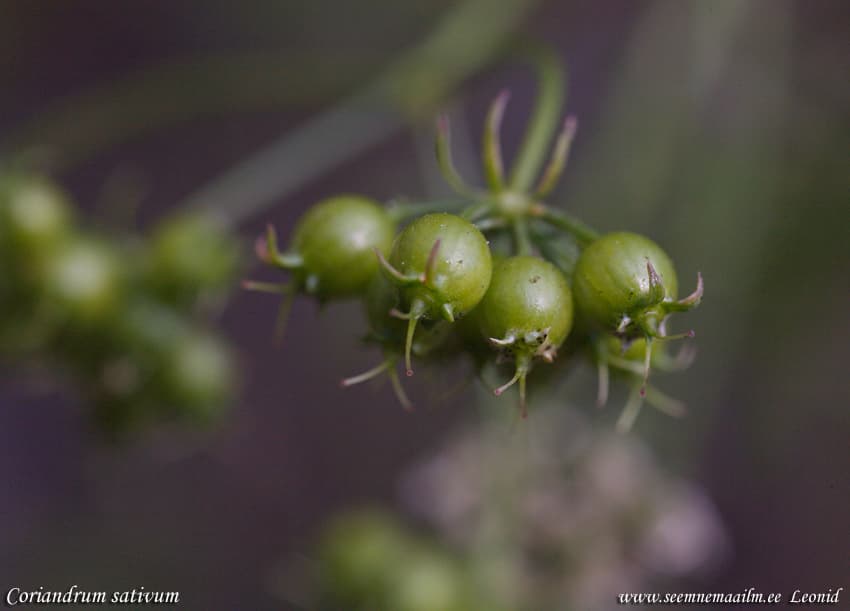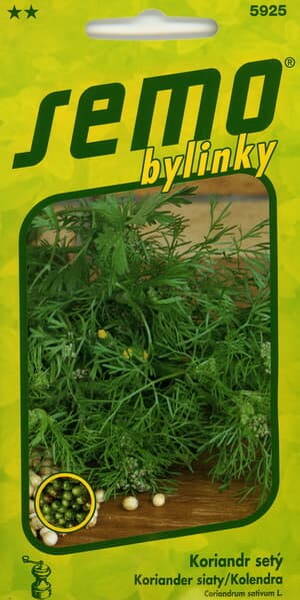Green seasoning, spicy fragrant seeds.
An annual, spicy, early ripening plant 40-70 cm high. Fresh herbs and seeds are used to flavour culinary and bread products.
Greens are harvested when the plants reach a height of 15-20 cm. To obtain seeds, the plants are mowed when the fruits are 40% brown and ripen in sheaves.
The culture is cold-resistant, withstands frosts down to -5°C. Seeds germinate at a temperature of +8+10°C in 12-18 days. Placed on light, rich soils.
Sowing: April (3) - July (1.2). 1 gram = 100 seeds.
Harvest: July - August.

Coriander is very popular and widely used in cooking.
It is also used as a medicinal and aromatic plant, as a raw material for the manufacture of cosmetic preparations. Dry seeds are especially valued.
In addition, coriander is bred as a magnificent ornamental plant. Its delicate finely dissected leaves cover the bushes with a delicate green cloud.
In July-September, large inflorescences-umbrellas, consisting of small white-pink flowers, rise above it. They exude a unique aroma.
Then, round-shaped fruits begin to ripen in umbrellas. They are harvested, dried and used as a culinary condiment.
Inflorescences with immature green seeds can be cut, dried and used to make dried flower arrangements.
Usually, coriander bushes reach a height of 50 cm, but for decorative purposes, it is better to plant the variety "Bengal Giant", whose shoots grow twice as high.
They are easier to cut and dry.
Coriander seeds are sown in a sunny place in ordinary garden soil between March and May. They begin to germinate at a temperature of +4+6°C.
At a soil temperature at a seeding depth of +10+12°C shoots appear after 20-22 days, and at a temperature of +15+17°C at 10-12 days.
The plant is relatively cold hardy. Young plantings tolerate frosts down to -5°C. (In southern countries, coriander overwinters well).
Prefers light, fertile, moist and non-acidic soils. The plant is photophilous.
Wonderful fruity aroma.
An annual essential oil and spice-flavoring plant of the umbrella family, 60-80 cm high. Cold-resistant, withstands -4-5°C.
The best predecessors are tilled crops. The most productive sowing is early spring (April - May), but winter sowing can also be used.
Seeding depth 2 cm, seeding rate 1 g/m2. The distance between rows is at least 25 cm, between plants - 6 cm. Seedlings appear in 2-3 weeks.
Care consists in loosening row spacings, weeding and watering.
To obtain a "green conveyor" crops are repeated after 18-20 days until mid-summer.
Greens are harvested before flowering and used for seasoning meat and vegetable dishes.
Seeds after full ripening (after 100-120 days) are used for making marinades and in baking.
Coriander is evidence that even an unpleasantly smelling plant can produce fruits that are pleasant in taste and smell.
Its name, which was used by Pliny, comes from the Greek "koris" (bug) and "anon" (anise).
Indeed, if you knead the fresh leaves of this plant, you will smell unpleasantly of bedbugs ...
However, its ripe fruits, used in combination with other spices, add a pleasant flavor to dishes.
For example, the basis of the well-known curry sauce is ground coriander seeds.
The leaves and stems of this crop are rich in vitamins B1, B2, C, P, carotene.
The fruits contain 0.2-1.0% essential oil and from 16 to 28% fatty industrial oil.
The main component of essential coriander oil is linalool, from which very valuable fragrant substances are obtained,
reminiscent of the smell of lemon, rose, violet, linden blossom.
The healing properties of coriander are due to the biological activity of the essential oil.
It has a variety of properties: choleretic, analgesic, antiseptic, wound healing and soothing.
In Indian medicine, coriander is used to increase the general tone of the body, as a diuretic, gastric and tonic.
* Tomatoes with coriander.
Tomatoes get a very unique aroma and taste from coriander, which will delight some, but will not please others...
Therefore, it is better to prepare 1-2 jars for testing, to understand: is this your product or not...
For canning tomatoes, it is better to use not dried seeds, but fresh ones, since freshly picked umbrellas with still unripe, but large coriander seeds are the most aromatic.
Scald ripe small tomatoes, put them in pre-sterilized jars, add 1 coriander umbrella to each jar and pour hot filling. Roll up and store in the refrigerator.
For filling: water - 1 l, salt - 1 tbsp., sugar - 1 tsp.
* Lightly salted cucumbers with mustard and coriander.
Before pickling, cover small young cucumbers with cold water and leave for several hours. Cut off the ends of the cucumbers. Lightly grind coriander and mustard seeds with a pestle in a mortar. Put some dill and chopped garlic on the bottom of the pickling jar. Place a row of cucumbers tightly, alternating them with dill and garlic sprigs. Sprinkle with coriander and mustard seeds on top.
Prepare the brine: boil water, add salt. Remove the boiling brine from the heat, pour in vinegar and immediately pour it over the cucumbers. Leave on the table until completely cool, then cover with a lid and put in the refrigerator for at least 2 days so that the cucumbers are well soaked.
Cucumbers - 1 kg, dill (thick stems with umbrellas) - 4-5 pcs., garlic - 1 head, coriander - 1 tsp, mustard (seeds) - 1 tbsp., vinegar (9%) - 1 teaspoon.
For the brine: water - 1 l, salt - 3 tablespoons.
* Salad of coriander, onion and dill.
Wash all the greens, chop finely, salt and season with vegetable oil.
Cilantro - 300 g, green onions - 200 g, dill - 100 g, vegetable oil and salt - to taste.
* Cabbage and coriander salad.
Place all the salad ingredients in a serving dish. In a separate bowl, mix all the dressing ingredients and pour into the salad. Sprinkle with sesame seeds, mix well and let it sit for a while (preferably in the refrigerator).
Cabbage - 1 head, green onions - 2 feathers, cilantro - 1 bunch, apple - 1 pc., sesame seeds - as much as needed.
For dressing: olive oil - 10 tbsp., juice of two lemons, salt - 1 tsp., sugar - 2 tsp.
* "Cheese" from plums with coriander.
For this appetizer, it is better to take easily boiled varieties of plums.
Wash the plums, remove the pits and sprinkle with a small amount of sugar. As soon as the juice is released, put the plums on low heat and cook until the consistency of thick jam.
Rub this mass through a colander or sieve, add coriander, stir and put in a bag made of thick fabric. Put under oppression for 3 days. Then grease the finished cheese with vegetable oil, roll in coriander (crush the seeds or grind them in a coffee grinder beforehand).
Fruit cheese is perfectly stored in a cool place for 2-3 years.
Plum - 1 kg, sugar - 100 g, coriander - to taste.
* Tomato sauce with coriander for pizza.
Cut tomatoes into quarters, put in an enamel bowl, leave for a day, then drain the released juice. Boil the remaining pulp over low heat to remove the skin, and rub into a puree or squeeze through a juicer. Put on low heat and cook until thickened, stirring constantly. Season with spices, salt and cook for another 3-5 minutes. Fry finely chopped onion in vegetable oil and add to the sauce. Mix thoroughly and cook for 5-10 minutes over low heat.
Tomatoes - 1 kg, garlic - 1 head, onions - 6 pcs., vegetable oil - 120 ml, hops-suneli - 30 g, coriander - 20 g, salt and ground red pepper - to taste.
* Carrot soup with coriander.
Melt the butter in a saucepan over low heat. Add chopped onion, lightly fry until soft. Add coriander, chopped carrots and potatoes. Cook for 10 minutes, stirring occasionally. Pour in the broth, bring to a boil, then reduce the heat and cover the pan with a lid. Cook for 20 minutes until the vegetables are soft. Mix everything in a blender until smooth. Then add the cheese, salt the carrot soup to taste and beat again. Transfer back to the pan, pour in the milk and heat. Butter - 25 g, onion - 1 pc., coriander - 0.5 tsp, carrots - 500 g, potatoes - 1 pc., chicken (or vegetable) broth - 1.2 l, cheddar cheese - 100 g, milk - 150 ml, salt - to taste.
* Potato soup with coriander and sausages.
Heat vegetable oil in a three-liter saucepan. Add coarsely chopped spicy sausages and brown on all sides. Add garlic and finely chopped onion, simmer until the onion is soft. Add ground coriander, mix well and pour in 1.5 liters of water. Add grated carrots and chopped parsley and potatoes, salt well.
Cook over medium heat until the potatoes are soft. Pour 1/3 of the soup into a separate bowl, in which it would be convenient to beat with a blender. Fish out the sausage pieces and return them to the pan with the remaining ingredients. Beat the poured portion of the soup with a blender until smooth and pour it back into the soup. Add cream, bring to a boil and remove from heat.
Serve the soup hot, sprinkled with green onions.
Onion - 1 pc., garlic - 2 cloves, vegetable oil - 3 tbsp., coriander (ground) - 1 tsp., spicy sausages - 200 g, potatoes - 3 pcs., carrots - 1 pc., parsley root - 1 pc., sour cream (or cream 30%) - 200 ml, salt - to taste, green onions - 0.5 bunch.
* Green pea soup with cilantro.
Peel and chop the onion. Peel, wash and dice the potatoes. Melt the butter in a saucepan, fry the onion. Add potatoes and simmer for 5-7 minutes over medium heat.
Set aside 3 tbsp of peas for serving, put the rest in the boiling broth, add the potatoes and onions and simmer for 10 minutes.
Wash the cilantro, dry it, pick off the leaves and chop coarsely. Set aside about 1 tbsp of leaves for serving, put the rest of the greens in the soup and simmer for another 1-2 minutes, then remove from heat.
Use an immersion blender to chop everything until it has a puree consistency, add the set aside peas and bring the soup to a boil. Season with salt, pepper, lemon juice and a pinch of sugar. Serve with cilantro leaves. You can pour 1 tbsp of heavy cream into each plate. Onion - 1 pc., potatoes - 200 g, canned green peas - 350 g, butter - 30 g, chicken broth - 750 ml, cilantro -1 bunch, lemon juice - 1 tsp, salt, ground black pepper and sugar - to taste.
* Baked pumpkin with garlic and coriander.
Peel the garlic, grind the coriander. Pour lemon juice into the olive oil, add salt, coriander, black pepper and garlic passed through a press.
Finely chop the parsley leaves and add to the oil mixture, then mix well.
Wash the pumpkin, cut it, remove the seeds (you can leave the peel on). Cut the pumpkin into 8 pieces.
Cover the baking dish with foil. Place the pumpkin slices in the dish, grease with the oil mixture. Cover the pumpkin pan with foil, place in an oven preheated to +200 °C and bake until the pumpkin is soft (35-45 minutes). At the end of baking, remove the foil and turn on the "Grill" mode for 5-7 minutes.
Pumpkin baked in this way can not only be served as is, but also used to make vegetable puree.
Pumpkin - 700 g, garlic - 2-3 cloves, olive oil - 3 tbsp., lemon juice - 1 tbsp., coriander - 1 tsp., salt - 1 tsp., parsley - 3-4 sprigs, ground black pepper - to taste.












